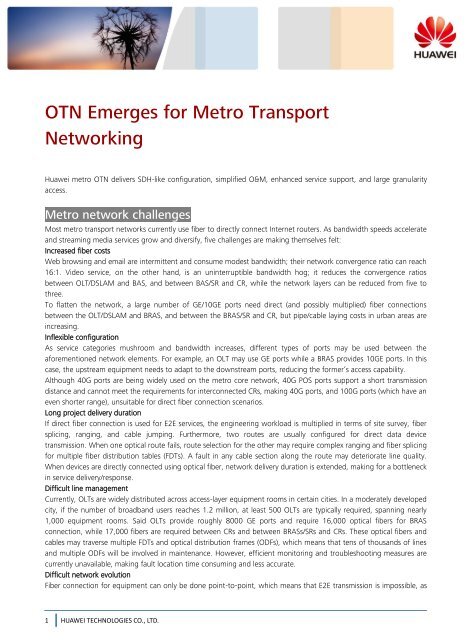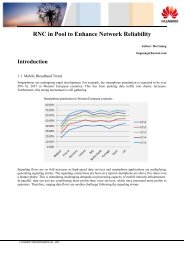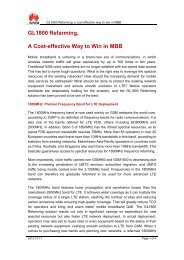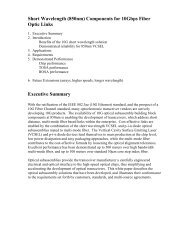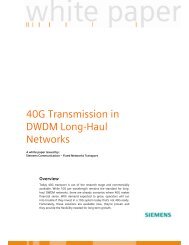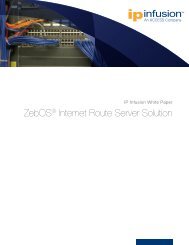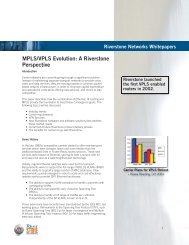OTN Emerges for Metro Transport Networking - Light Reading
OTN Emerges for Metro Transport Networking - Light Reading
OTN Emerges for Metro Transport Networking - Light Reading
Create successful ePaper yourself
Turn your PDF publications into a flip-book with our unique Google optimized e-Paper software.
<strong>OTN</strong> <strong>Emerges</strong> <strong>for</strong> <strong>Metro</strong> <strong>Transport</strong><br />
<strong>Networking</strong><br />
Huawei metro <strong>OTN</strong> delivers SDH-like configuration, simplified O&M, enhanced service support, and large granularity<br />
access.<br />
<strong>Metro</strong> network challenges<br />
Most metro transport networks currently use fiber to directly connect Internet routers. As bandwidth speeds accelerate<br />
and streaming media services grow and diversify, five challenges are making themselves felt:<br />
Increased fiber costs<br />
Web browsing and email are intermittent and consume modest bandwidth; their network convergence ratio can reach<br />
16:1. Video service, on the other hand, is an uninterruptible bandwidth hog; it reduces the convergence ratios<br />
between OLT/DSLAM and BAS, and between BAS/SR and CR, while the network layers can be reduced from five to<br />
three.<br />
To flatten the network, a large number of GE/10GE ports need direct (and possibly multiplied) fiber connections<br />
between the OLT/DSLAM and BRAS, and between the BRAS/SR and CR, but pipe/cable laying costs in urban areas are<br />
increasing.<br />
Inflexible configuration<br />
As service categories mushroom and bandwidth increases, different types of ports may be used between the<br />
a<strong>for</strong>ementioned network elements. For example, an OLT may use GE ports while a BRAS provides 10GE ports. In this<br />
case, the upstream equipment needs to adapt to the downstream ports, reducing the <strong>for</strong>mer’s access capability.<br />
Although 40G ports are being widely used on the metro core network, 40G POS ports support a short transmission<br />
distance and cannot meet the requirements <strong>for</strong> interconnected CRs, making 40G ports, and 100G ports (which have an<br />
even shorter range), unsuitable <strong>for</strong> direct fiber connection scenarios.<br />
Long project delivery duration<br />
If direct fiber connection is used <strong>for</strong> E2E services, the engineering workload is multiplied in terms of site survey, fiber<br />
splicing, ranging, and cable jumping. Furthermore, two routes are usually configured <strong>for</strong> direct data device<br />
transmission. When one optical route fails, route selection <strong>for</strong> the other may require complex ranging and fiber splicing<br />
<strong>for</strong> multiple fiber distribution tables (FDTs). A fault in any cable section along the route may deteriorate line quality.<br />
When devices are directly connected using optical fiber, network delivery duration is extended, making <strong>for</strong> a bottleneck<br />
in service delivery/response.<br />
Difficult line management<br />
Currently, OLTs are widely distributed across access-layer equipment rooms in certain cities. In a moderately developed<br />
city, if the number of broadband users reaches 1.2 million, at least 500 OLTs are typically required, spanning nearly<br />
1,000 equipment rooms. Said OLTs provide roughly 8000 GE ports and require 16,000 optical fibers <strong>for</strong> BRAS<br />
connection, while 17,000 fibers are required between CRs and between BRASs/SRs and CRs. These optical fibers and<br />
cables may traverse multiple FDTs and optical distribution frames (ODFs), which means that tens of thousands of lines<br />
and multiple ODFs will be involved in maintenance. However, efficient monitoring and troubleshooting measures are<br />
currently unavailable, making fault location time consuming and less accurate.<br />
Difficult network evolution<br />
Fiber connection <strong>for</strong> equipment can only be done point-to-point, which means that E2E transmission is impossible, as<br />
1 HUAWEI TECHNOLOGIES CO., LTD.
there is no network transport plat<strong>for</strong>m, while plug-and-play functionality, service evolution, capacity expansion, and<br />
multiple service protection are hardly available.<br />
<strong>Metro</strong> <strong>OTN</strong> is emerging<br />
These challenges are driving many operators to simplify their OAM and upgrade their hardware, architecture, and<br />
services <strong>for</strong> metro <strong>OTN</strong>, which is currently being moved from the metro core layer to the convergence and even the<br />
access layer, enabling ultra-broadband service support. However, <strong>OTN</strong> network usage and OAM efficiency can be<br />
improved in the following areas:<br />
Simplified <strong>OTN</strong> deployment<br />
Many elements are involved in metro <strong>OTN</strong> planning and deployment, including wavelengths, OSNR margins, chromatic<br />
dispersion (CD) compensation, and polarization mode dispersion (PMD) compensation; simplifying them would ease<br />
network planning and deployment remarkably.<br />
Huawei has developed an intelligent <strong>OTN</strong> planning tool that greatly accelerates the process. Fiber connections and<br />
optical/electrical-layer configurations can be shared between this tool and the Huawei NMS, freeing engineers from<br />
the chores of complex planning and computation. For service configuration at multiple layers that span the client,<br />
ODUk, OTUk, OCh, OMS, and OTH, engineers need only create OCh and client services using the NMS, as services at<br />
the other layers will be automatically delivered by the NMS, reducing service provisioning time by 60%.<br />
Moreover, Huawei also offers an innovative optoelectronic integrated chip (PID) solution where each PID port outputs<br />
200G traffic, enabling this solution to use an SDH-like design and PDI-line boards with different specifications to meet<br />
different transmission distances, eliminating the need <strong>for</strong> complex wavelength planning, board selection, OSNR<br />
calculation, and OA board computation.<br />
End-to-end <strong>OTN</strong> network OAM<br />
<strong>Metro</strong> <strong>OTN</strong> networks require end-to-end OAM capabilities similar to those <strong>for</strong> SDH networks. Huawei's metro <strong>OTN</strong><br />
networking supports resource usage statistics at the electrical layer (especially the ODU1/2/3 layer of the OCh) and the<br />
optical layer between WDM NEs, while also supporting client-side port resource statistics, facilitating the clear display<br />
of resource usage status, and per<strong>for</strong>ming expansion planning.<br />
Bidirectional WDM trails on <strong>OTN</strong> networks must be connected to prevent residual cross-connections when a channel is<br />
deleted. <strong>OTN</strong> networks should be monitored in terms of optical-layer network per<strong>for</strong>mance, end-to-end OAM <strong>for</strong><br />
cross-connections, wavelengths, sub-wavelengths, and Ethernet services. Huawei's metro <strong>OTN</strong> supports Layer 2<br />
features similar to those <strong>for</strong> Ethernet data services, greatly reducing the time spent on onsite maintenance.<br />
With Huawei <strong>OTN</strong> networking, regeneration boards are configured <strong>for</strong> each PID site; this SDH-like design enables<br />
timely fault location, while PID sites require only standard maintenance skills, meaning that they can be maintained by<br />
regular SDH engineers.<br />
Huawei's metro <strong>OTN</strong> solutions can help operators boost their network operations, thanks to a number of enhanced<br />
features such as PID and <strong>OTN</strong> integration, expanded <strong>OTN</strong> cross-connection, and simplified <strong>OTN</strong> planning and O&M.<br />
2 HUAWEI TECHNOLOGIES CO., LTD.


